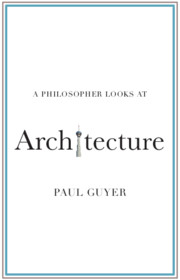
-
Select format
-
- Publisher:
- Cambridge University Press
- Publication date:
- May 2021
- May 2021
- ISBN:
- 9781108907019
- 9781108820424
- Dimensions:
- Weight & Pages:
- Dimensions:
- (198 x 129 mm)
- Weight & Pages:
- 0.28kg, 216 Pages
- Subjects:
- Philosophy: General Interest, Art, Philosophy, Architecture
- Series:
- A Philosopher Looks At
You may already have access via personal or institutional login- Subjects:
- Philosophy: General Interest, Art, Philosophy, Architecture
- Series:
- A Philosopher Looks At
Book description
What should our buildings look like? Or is their usability more important than their appearance? Paul Guyer argues that the fundamental goals of architecture first identified by the Roman architect Marcus Pollio Vitruvius - good construction, functionality, and aesthetic appeal - have remained valid despite constant changes in human activities, building materials and technologies, as well as in artistic styles and cultures. Guyer discusses philosophers and architects throughout history, including Alberti, Kant, Ruskin, Wright, and Loos, and surveys the ways in which their ideas are brought to life in buildings across the world. He also considers the works and words of contemporary architects including Annabelle Selldorf, Herzog and de Meuron, and Steven Holl, and shows that - despite changing times and fashions - good architecture continues to be something worth striving for. This new series offers short and personal perspectives by expert thinkers on topics that we all encounter in our everyday lives.
Reviews
‘Recommended.’
D. Stillman Source: Choice Magazine
Contents
Metrics
Altmetric attention score
Full text views
Full text views help Loading metrics...
Loading metrics...
* Views captured on Cambridge Core between #date#. This data will be updated every 24 hours.
Usage data cannot currently be displayed.
Accessibility standard: Unknown
Why this information is here
This section outlines the accessibility features of this content - including support for screen readers, full keyboard navigation and high-contrast display options. This may not be relevant for you.
Accessibility Information
Accessibility compliance for the PDF of this book is currently unknown and may be updated in the future.


